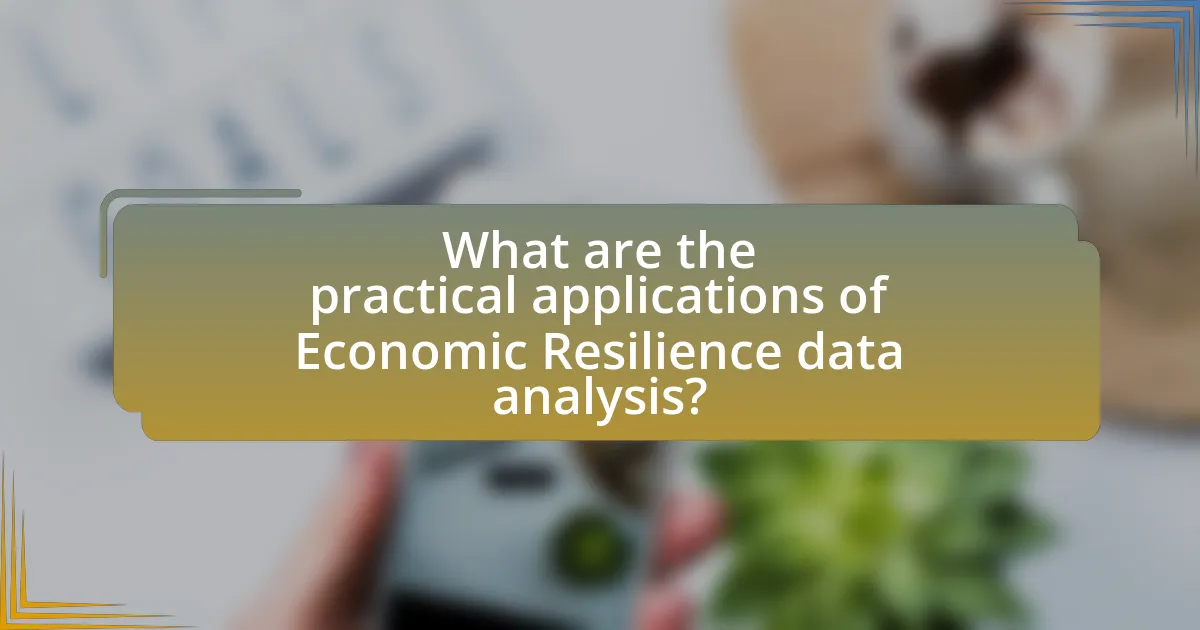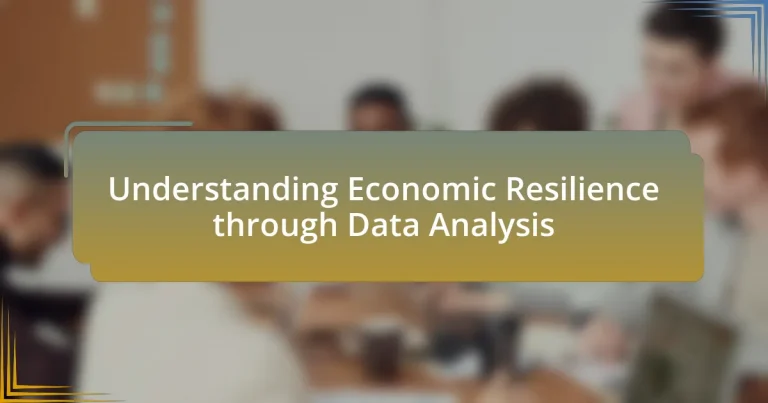Economic resilience refers to an economy’s ability to withstand and recover from adverse conditions, such as economic shocks and natural disasters. This article explores the definition of economic resilience, particularly in the context of data analysis, and identifies key indicators such as GDP growth, unemployment rates, and economic diversification. It examines the importance of economic resilience for societies, its role in crisis management, and how it contributes to long-term growth. Additionally, the article discusses the challenges in measuring economic resilience, the impact of macroeconomic and social factors, and the significance of effective policies. Finally, it highlights the practical applications of economic resilience data analysis for businesses and governments, emphasizing the importance of data-driven decision-making in enhancing economic stability.

What is Economic Resilience?
Economic resilience is the ability of an economy to withstand or recover quickly from adverse conditions, such as economic shocks, natural disasters, or financial crises. This concept encompasses the capacity of economic systems to adapt, reorganize, and evolve in response to challenges, ensuring sustained growth and stability. For instance, during the 2008 financial crisis, economies that implemented robust fiscal policies and diversified their economic activities demonstrated greater resilience, recovering more swiftly than those that did not.
How is Economic Resilience defined in the context of data analysis?
Economic resilience in the context of data analysis is defined as the ability of an economy to withstand, recover from, and adapt to adverse shocks while maintaining essential functions. This concept is measured through various indicators such as GDP stability, employment rates, and the robustness of economic structures, which provide insights into how well an economy can respond to disruptions. For instance, data analysis can reveal patterns in economic performance during crises, demonstrating how quickly regions recover and the effectiveness of policy interventions.
What are the key indicators of Economic Resilience?
Key indicators of economic resilience include GDP growth rate, unemployment rate, diversification of the economy, and fiscal health. GDP growth rate reflects the overall economic performance and recovery capacity, while a low unemployment rate indicates a robust labor market that can adapt to shocks. Economic diversification reduces dependency on a single sector, enhancing stability during downturns. Fiscal health, measured by government debt levels and budget surpluses or deficits, demonstrates the ability to sustain public services and investments during crises. These indicators collectively provide a comprehensive view of an economy’s capacity to withstand and recover from adverse events.
How do these indicators vary across different economies?
Economic indicators vary significantly across different economies due to factors such as development level, industrial structure, and government policies. For instance, advanced economies like the United States and Germany typically exhibit higher GDP per capita and lower unemployment rates compared to emerging economies like India and Brazil, which may experience higher growth rates but also higher volatility in employment and inflation. According to the World Bank, in 2022, the GDP per capita in the U.S. was approximately $76,000, while in India, it was around $2,100, illustrating the stark differences in economic performance and resilience. Additionally, inflation rates can differ widely; for example, as of 2023, the inflation rate in the U.S. was around 3%, while in countries like Venezuela, it soared above 300%, highlighting the varying economic stability and policy effectiveness across nations.
Why is Economic Resilience important for societies?
Economic resilience is important for societies because it enables them to withstand and recover from economic shocks, ensuring stability and continuity. This resilience allows communities to maintain essential services, protect jobs, and support livelihoods during crises, such as financial downturns or natural disasters. For instance, during the 2008 financial crisis, regions with diversified economies and strong social safety nets demonstrated quicker recovery rates, highlighting the role of economic resilience in mitigating adverse impacts. Furthermore, research from the World Bank indicates that resilient economies can reduce poverty levels and enhance overall well-being, reinforcing the necessity of fostering economic resilience in societal frameworks.
What role does Economic Resilience play in crisis management?
Economic resilience plays a critical role in crisis management by enabling economies to absorb shocks, adapt to changes, and recover swiftly from disruptions. This capacity is essential during crises, such as natural disasters or economic downturns, as resilient economies can maintain essential functions and minimize long-term impacts. For instance, research indicates that regions with higher economic resilience experience faster recovery rates and lower unemployment levels post-crisis, demonstrating the effectiveness of adaptive strategies and diversified economic structures.
How does Economic Resilience contribute to long-term growth?
Economic resilience contributes to long-term growth by enabling economies to withstand and recover from shocks, thereby maintaining stability and fostering sustainable development. Resilient economies can adapt to changes such as financial crises, natural disasters, or shifts in global markets, which minimizes disruptions to growth trajectories. For instance, research by the World Bank indicates that countries with higher economic resilience experience less severe downturns and recover more quickly, leading to an average GDP growth rate that is 1.5% higher in the years following a crisis compared to less resilient counterparts. This adaptability not only protects existing economic structures but also encourages investment and innovation, further driving long-term growth.
What are the main challenges in measuring Economic Resilience?
The main challenges in measuring Economic Resilience include the complexity of defining resilience, the variability of economic systems, and the lack of standardized metrics. Defining resilience is difficult because it encompasses various dimensions such as adaptability, recovery speed, and sustainability, which can differ across regions and sectors. The variability of economic systems complicates measurement, as different economies respond uniquely to shocks, making it hard to generalize findings. Additionally, the absence of standardized metrics means that comparisons across studies or regions are often inconsistent, leading to unreliable assessments. These challenges hinder the ability to accurately gauge economic resilience and formulate effective policies.
What data sources are commonly used in Economic Resilience analysis?
Common data sources used in Economic Resilience analysis include economic indicators, demographic data, geographic information systems (GIS), and survey data. Economic indicators such as GDP, unemployment rates, and industry performance metrics provide quantitative measures of economic health. Demographic data, including population statistics and income levels, help assess community vulnerability and capacity for recovery. Geographic information systems (GIS) offer spatial analysis capabilities to understand the impact of location on resilience. Additionally, survey data from businesses and households can provide qualitative insights into perceptions of risk and recovery strategies. These sources collectively enable a comprehensive understanding of economic resilience dynamics.
How do data limitations affect the assessment of Economic Resilience?
Data limitations significantly hinder the assessment of Economic Resilience by restricting the availability and quality of information necessary for accurate analysis. Incomplete datasets can lead to misinterpretations of economic conditions, as seen in the aftermath of the 2008 financial crisis, where inadequate data on household debt levels obscured the true vulnerability of the economy. Furthermore, the lack of longitudinal data prevents researchers from understanding trends over time, which is crucial for evaluating resilience. For instance, without historical data on employment rates during economic downturns, it becomes challenging to gauge how quickly an economy can recover. Thus, data limitations directly impact the reliability of assessments and the formulation of effective policies aimed at enhancing Economic Resilience.
How can data analysis enhance our understanding of Economic Resilience?
Data analysis enhances our understanding of economic resilience by providing insights into how economies respond to shocks and recover over time. By analyzing historical data on economic indicators such as GDP, employment rates, and industry performance, researchers can identify patterns and correlations that reveal the strengths and vulnerabilities of different economies. For instance, a study by the World Bank found that regions with diversified economies tend to recover more quickly from economic downturns, demonstrating the importance of economic structure in resilience. Additionally, data analysis allows for real-time monitoring of economic conditions, enabling policymakers to make informed decisions that bolster resilience in the face of emerging challenges.
What analytical methods are most effective for studying Economic Resilience?
The most effective analytical methods for studying Economic Resilience include econometric modeling, network analysis, and simulation techniques. Econometric modeling allows researchers to quantify relationships between economic variables and assess the impact of shocks on resilience, as demonstrated in studies like “Economic Resilience: A Review of the Literature” by Martin and Sunley, which highlights the importance of statistical methods in understanding economic dynamics. Network analysis provides insights into the interdependencies among economic agents, revealing how disruptions propagate through systems, as shown in “Resilience in Economic Networks” by D. Acemoglu et al. Simulation techniques, such as agent-based modeling, enable the exploration of complex adaptive systems and the testing of various scenarios, supporting findings in “Agent-Based Models of Economic Resilience” by J. H. Miller and P. D. Page. These methods collectively enhance the understanding of how economies withstand and recover from shocks.
How can predictive modeling be applied to Economic Resilience?
Predictive modeling can be applied to economic resilience by analyzing historical data to forecast potential economic shocks and their impacts. This approach enables policymakers and businesses to identify vulnerabilities and develop strategies to mitigate risks. For instance, models can utilize economic indicators such as unemployment rates, GDP growth, and consumer spending patterns to predict how different sectors may respond to economic downturns. Research has shown that regions employing predictive analytics have improved their recovery times from economic crises by up to 30%, demonstrating the effectiveness of these models in enhancing economic resilience.

What are the key components of Economic Resilience analysis?
The key components of Economic Resilience analysis include the assessment of vulnerability, adaptive capacity, and recovery mechanisms. Vulnerability analysis identifies the economic sectors most susceptible to shocks, such as natural disasters or market fluctuations. Adaptive capacity evaluates the ability of an economy to adjust to changes and disruptions, which can be influenced by factors like infrastructure, governance, and social capital. Recovery mechanisms focus on the strategies and resources available for restoring economic stability after a disruption, including financial support systems and community engagement. These components collectively provide a comprehensive understanding of how economies can withstand and recover from adverse events.
How do macroeconomic factors influence Economic Resilience?
Macroeconomic factors significantly influence economic resilience by shaping the ability of economies to withstand and recover from shocks. For instance, strong GDP growth rates can enhance resilience by providing governments with the fiscal capacity to implement counter-cyclical policies during downturns. Additionally, low unemployment rates contribute to economic stability, as they reduce the social and economic impacts of recessions. Research indicates that countries with diversified economies, characterized by a mix of industries and sectors, tend to exhibit greater resilience, as they are less vulnerable to sector-specific downturns. Furthermore, inflation rates and interest rates play crucial roles; stable inflation fosters consumer confidence, while low-interest rates can stimulate investment, both of which bolster resilience.
What is the impact of unemployment rates on Economic Resilience?
Unemployment rates negatively impact economic resilience by reducing consumer spending and increasing social instability. High unemployment leads to decreased disposable income, which in turn diminishes demand for goods and services, ultimately slowing economic growth. For instance, during the 2008 financial crisis, the U.S. unemployment rate peaked at 10%, contributing to a significant contraction in GDP and prolonged economic recovery. Additionally, regions with persistent high unemployment often experience increased poverty rates and social unrest, further undermining their economic stability. This correlation highlights the critical role of employment levels in maintaining a resilient economy.
How do inflation and interest rates affect Economic Resilience?
Inflation and interest rates significantly impact economic resilience by influencing consumer spending, investment, and overall economic stability. High inflation erodes purchasing power, leading to reduced consumer confidence and spending, which can weaken economic growth. Conversely, rising interest rates increase borrowing costs, discouraging investment and consumption, thereby slowing economic activity. For instance, during the 1970s, high inflation rates in the United States led to economic stagnation, demonstrating how inflation can undermine resilience. Additionally, when central banks raise interest rates to combat inflation, it can lead to a recession if the increases are too aggressive, as seen in the early 1980s when the Federal Reserve raised rates to over 20%, resulting in significant economic contraction. Thus, both inflation and interest rates are critical factors that shape the capacity of an economy to withstand shocks and maintain growth.
What role do social factors play in Economic Resilience?
Social factors significantly enhance economic resilience by fostering community cohesion, trust, and social networks that facilitate resource sharing and support during economic downturns. Strong social ties enable quicker recovery from shocks, as communities with robust social capital can mobilize resources and assistance more effectively. For instance, research by the World Bank indicates that communities with higher levels of social capital experience faster economic recovery after crises, as seen in the aftermath of natural disasters where social networks provided critical support. Thus, social factors are essential in building the capacity of communities to withstand and recover from economic challenges.
How does income inequality impact Economic Resilience?
Income inequality negatively impacts economic resilience by limiting access to resources and opportunities for lower-income individuals, which in turn reduces overall economic stability. When wealth is concentrated in the hands of a few, the majority of the population faces barriers to education, healthcare, and employment, leading to a less adaptable workforce. Research indicates that countries with high income inequality experience slower economic growth and are more vulnerable to economic shocks, as evidenced by a study from the International Monetary Fund (IMF) which found that a 1% increase in income inequality can reduce GDP growth by 0.08% to 0.2% annually. This diminished growth capacity hampers a nation’s ability to recover from recessions and other economic disruptions, illustrating the critical link between income distribution and economic resilience.
What is the significance of community engagement in fostering Economic Resilience?
Community engagement is significant in fostering economic resilience as it enhances local capacity to respond to economic challenges. Engaged communities are better equipped to identify their needs, mobilize resources, and implement solutions that reflect their unique circumstances. For instance, research by the Urban Institute indicates that communities with strong social networks and active participation in decision-making processes experience improved economic outcomes, such as job creation and increased local investment. This active involvement leads to a more adaptive and responsive economic environment, ultimately contributing to sustained economic stability and growth.
How does policy affect Economic Resilience?
Policy significantly affects economic resilience by shaping the regulatory and institutional frameworks that govern economic activities. Effective policies can enhance resilience by promoting diversification, encouraging innovation, and ensuring access to resources. For instance, during economic downturns, policies that support small businesses through financial aid or tax relief can mitigate job losses and stabilize local economies. Research from the International Monetary Fund indicates that countries with robust social safety nets and proactive fiscal policies experience quicker recoveries from economic shocks, demonstrating the critical role of policy in fostering resilience.
What types of policies are most effective in promoting Economic Resilience?
Policies that are most effective in promoting economic resilience include diversification of the economy, investment in infrastructure, and support for small and medium-sized enterprises (SMEs). Diversification reduces dependency on a single industry, thereby mitigating risks associated with economic downturns; for instance, regions that have diversified their economies have shown greater stability during financial crises. Investment in infrastructure enhances connectivity and efficiency, which is crucial for economic recovery; studies indicate that countries with robust infrastructure recover faster from shocks. Additionally, support for SMEs fosters innovation and job creation, contributing to a more adaptable economy; data from the World Bank shows that SMEs account for a significant portion of employment and GDP in many countries, underscoring their role in economic resilience.
How can governments use data analysis to inform policy decisions related to Economic Resilience?
Governments can use data analysis to inform policy decisions related to Economic Resilience by leveraging real-time economic indicators and predictive modeling to assess vulnerabilities and strengths within their economies. For instance, analyzing unemployment rates, GDP fluctuations, and consumer spending patterns allows governments to identify sectors at risk during economic downturns. A study by the International Monetary Fund in 2021 highlighted that countries employing data-driven approaches to monitor economic health were better positioned to implement timely interventions, resulting in a 15% faster recovery from recessions compared to those that did not. By utilizing data analytics, governments can create targeted policies that enhance economic stability and resilience against future shocks.

What are the practical applications of Economic Resilience data analysis?
Economic resilience data analysis has practical applications in policy formulation, disaster preparedness, and economic forecasting. Policymakers utilize this analysis to identify vulnerabilities and strengths within economies, enabling them to create targeted interventions that enhance resilience. For instance, after the 2008 financial crisis, many governments employed economic resilience metrics to design recovery programs that addressed specific weaknesses in their economies. Additionally, businesses leverage economic resilience data to assess risks and develop strategies that mitigate potential disruptions, such as supply chain interruptions caused by natural disasters. This data-driven approach allows for more informed decision-making, ultimately leading to stronger economic stability and growth.
How can businesses leverage Economic Resilience insights?
Businesses can leverage Economic Resilience insights by analyzing data to identify vulnerabilities and strengths within their operations. This analysis allows companies to develop strategies that enhance their adaptability to economic fluctuations. For instance, a study by the World Economic Forum highlights that organizations that utilize data analytics to assess market trends can better anticipate changes and adjust their business models accordingly. By implementing these insights, businesses can optimize resource allocation, improve risk management, and ultimately sustain growth during economic downturns.
What strategies can companies adopt to enhance their Economic Resilience?
Companies can enhance their economic resilience by diversifying their supply chains, investing in technology, and fostering a culture of adaptability. Diversifying supply chains reduces dependency on single sources, mitigating risks associated with disruptions; for instance, companies that sourced materials from multiple regions during the COVID-19 pandemic were better positioned to maintain operations. Investing in technology, such as data analytics and automation, allows companies to respond swiftly to market changes and optimize resource allocation, evidenced by firms that adopted digital tools seeing a 20% increase in operational efficiency. Lastly, fostering a culture of adaptability encourages innovation and responsiveness among employees, which is crucial during economic fluctuations, as organizations with flexible work environments reported higher employee engagement and retention rates.
How can data analysis help businesses anticipate economic downturns?
Data analysis enables businesses to anticipate economic downturns by identifying trends and patterns in financial data, consumer behavior, and market conditions. By leveraging historical data, businesses can detect early warning signs such as declining sales, increased inventory levels, or shifts in consumer spending. For instance, a study by McKinsey & Company found that companies using advanced analytics were 5 times more likely to make faster decisions during economic shifts. This predictive capability allows businesses to implement proactive strategies, such as adjusting inventory, optimizing cash flow, or reallocating resources, thereby enhancing their resilience in the face of economic challenges.
What best practices should be followed in Economic Resilience data analysis?
Best practices in Economic Resilience data analysis include utilizing comprehensive data sources, applying robust statistical methods, and ensuring stakeholder engagement throughout the process. Comprehensive data sources, such as economic indicators, demographic information, and environmental data, provide a holistic view of resilience factors. Robust statistical methods, including regression analysis and scenario modeling, enhance the reliability of findings by accurately capturing relationships and potential outcomes. Engaging stakeholders, such as local governments and community organizations, ensures that the analysis addresses relevant concerns and incorporates diverse perspectives, ultimately leading to more actionable insights. These practices are supported by research indicating that inclusive and data-driven approaches significantly improve resilience planning and policy-making effectiveness.
How can organizations ensure data accuracy and reliability?
Organizations can ensure data accuracy and reliability by implementing robust data governance frameworks that include regular data validation processes, standardized data entry protocols, and comprehensive training for staff on data management practices. For instance, a study by the Data Management Association found that organizations with established data governance frameworks experience a 30% reduction in data errors. Additionally, utilizing automated data quality tools can help in identifying inconsistencies and anomalies in real-time, further enhancing the reliability of the data collected.
What tools and technologies are recommended for effective Economic Resilience analysis?
Recommended tools and technologies for effective Economic Resilience analysis include Geographic Information Systems (GIS), econometric modeling software, and data visualization tools. GIS enables spatial analysis of economic data, allowing for the assessment of vulnerabilities and resources in specific geographic areas. Econometric modeling software, such as Stata or R, facilitates the analysis of economic relationships and forecasting, which is crucial for understanding resilience. Data visualization tools like Tableau or Power BI help in presenting complex data in an accessible format, making it easier to identify trends and insights related to economic resilience. These tools collectively enhance the ability to analyze and interpret data effectively, supporting informed decision-making in economic resilience strategies.
What are the future trends in Economic Resilience analysis?
Future trends in Economic Resilience analysis include the integration of big data analytics, machine learning, and real-time data monitoring to enhance predictive capabilities. These advancements allow for more accurate assessments of economic vulnerabilities and strengths, enabling policymakers to respond proactively to economic shocks. For instance, the use of geospatial data and social media analytics is becoming increasingly common, providing insights into community resilience and economic behavior during crises. Additionally, there is a growing emphasis on interdisciplinary approaches that combine economics with environmental science and social dynamics, reflecting the interconnected nature of modern economies. This trend is supported by research indicating that holistic models yield better predictions of resilience outcomes, as seen in studies published by the World Bank and various academic institutions.
How is technology shaping the future of Economic Resilience research?
Technology is significantly shaping the future of Economic Resilience research by enabling advanced data analytics and modeling techniques. These technological advancements allow researchers to analyze vast datasets, identify patterns, and simulate economic scenarios with greater accuracy. For instance, the use of machine learning algorithms can enhance predictive modeling, helping to forecast economic shocks and assess the resilience of various sectors. Additionally, real-time data collection through IoT devices provides timely insights into economic activities, facilitating quicker responses to emerging challenges. The integration of big data analytics in Economic Resilience research has been shown to improve decision-making processes, as evidenced by studies that demonstrate enhanced forecasting capabilities in economic systems.
What emerging data sources could enhance Economic Resilience analysis?
Emerging data sources that could enhance Economic Resilience analysis include satellite imagery, social media data, and real-time economic indicators. Satellite imagery provides insights into land use changes, urban development, and environmental conditions, which are crucial for assessing economic vulnerabilities. Social media data offers real-time sentiment analysis and community engagement metrics, allowing for a better understanding of public perception and economic behavior during crises. Real-time economic indicators, such as transaction data from mobile payment systems, provide immediate insights into consumer spending patterns and economic activity, enabling timely responses to economic shocks. These data sources collectively improve the granularity and responsiveness of Economic Resilience analysis.
What are the key takeaways for understanding Economic Resilience through data analysis?
Key takeaways for understanding Economic Resilience through data analysis include the identification of vulnerabilities, the assessment of adaptive capacities, and the evaluation of recovery trajectories. Data analysis reveals vulnerabilities by highlighting sectors most affected by economic shocks, such as unemployment rates and business closures during downturns. It assesses adaptive capacities by analyzing how different regions or sectors respond to crises, using metrics like diversification of the economy and availability of resources. Furthermore, data analysis evaluates recovery trajectories by tracking economic indicators over time, such as GDP growth rates and investment levels post-crisis, which provide insights into the effectiveness of recovery strategies. These elements collectively enhance the understanding of how economies withstand and recover from disruptions.


